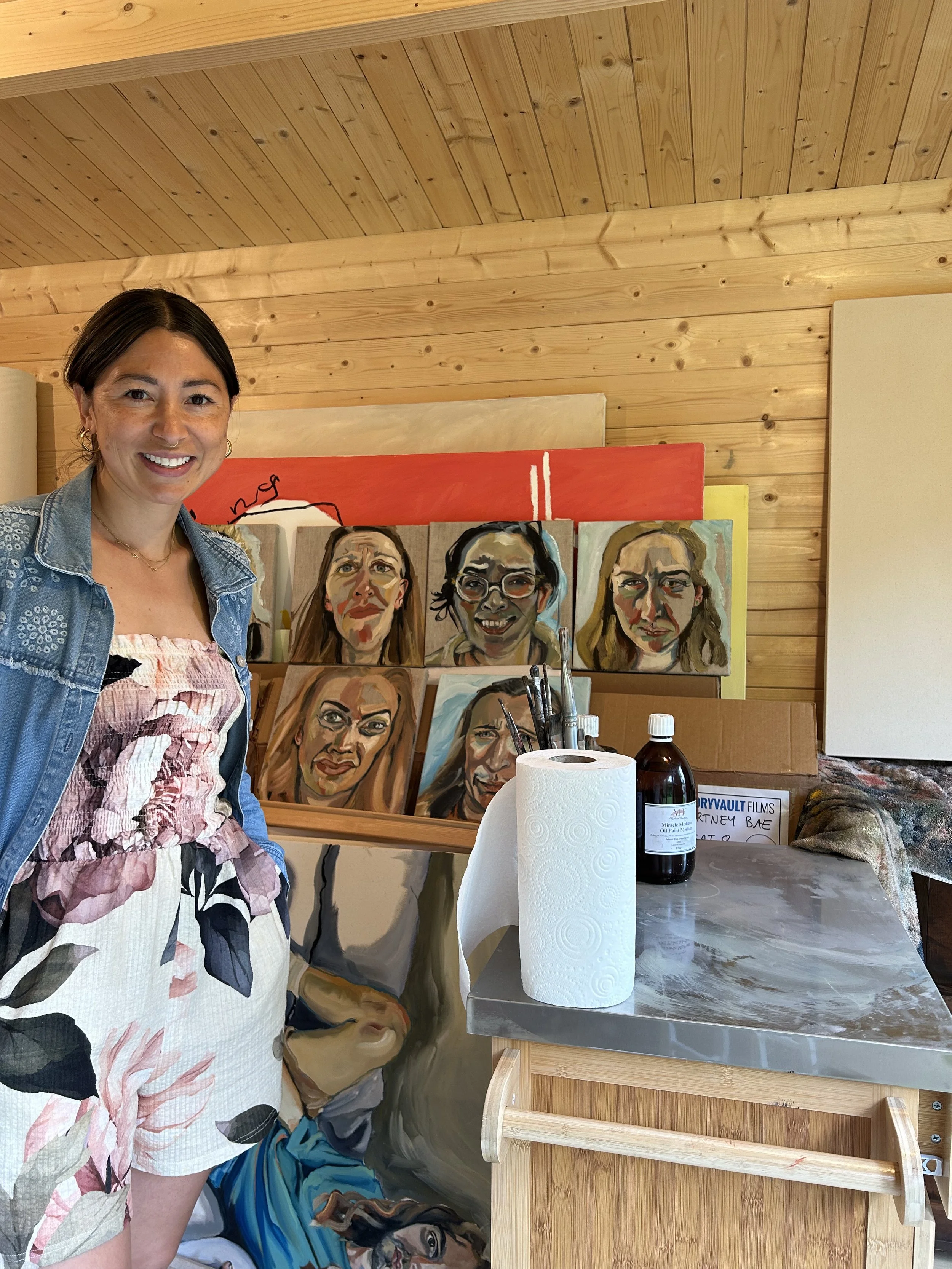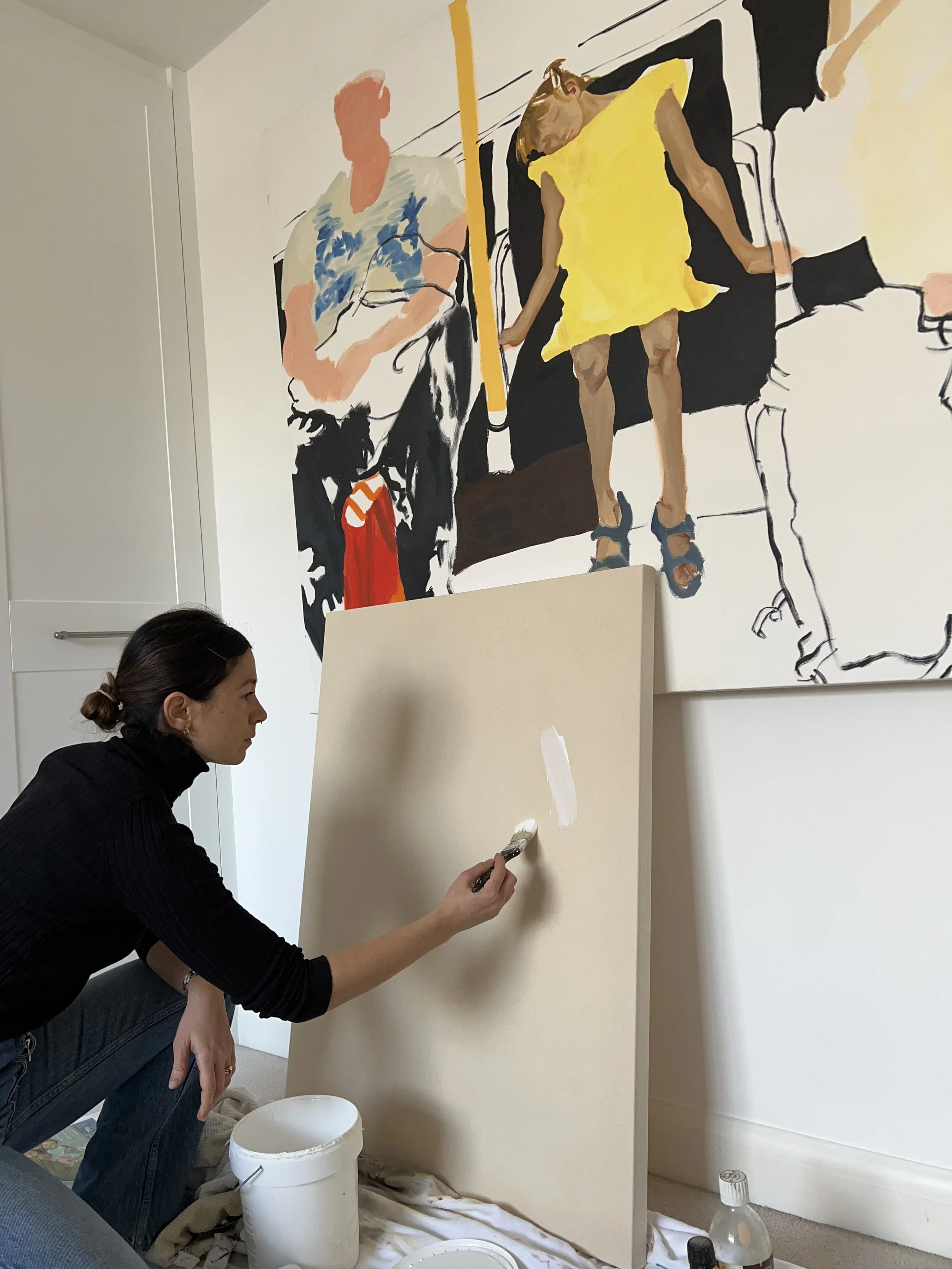ARTIST INTERVIEW: COURTNEY BAE
Courtney Bae
In your biography you state that you were inspired by your father's 'expressive Chinese brushwork paintings'. Did you know from a young age that you wanted to pursue a career in art? Has your father's work been influential to your own work?
I loved to watch my father paint with his gouache and ink on rice paper. The painting teacher would give my sister and I a still life to work on. It was most likely just to get us to go away, but I enjoyed it so much and it felt like it was our painting lesson just as much as it was his. When I got to school, I think many things distracted me but in my last two years of secondary school it was quite clear to me that I was very creative and passionate about oil painting somehow. I painted for my final year 12 art submission and it was well received. It was a series of 6 enormous works; 200cm x 50cm of my best friend and it was centred around sleep paralysis. For me at this time, I was very serious about my painting but not in a way that had any impact on my career for some reason. I simply enjoyed it for what it was.
You studied Fashion Design at The Fashion Institute of Technology in New York and went on to gain experience in luxury fashion. How has your background in fashion been instrumental to your paintings?
I think as I got older my creativity simply found a new medium. I gravitated towards fashion because I saw the joy in styling and expressing oneself but I also adored the passion and craftsmanship that came through in luxury goods. If you can set aside all of the moral and environmental problems with selling luxury goods, then you can at least appreciate that many people spent hours designing, creating and crafting with beautiful tools and skills all to produce this object whatever it might be, that has been born out of an immense amount of love. A lot of inspiration does come through my time with Miu Miu and Prada and it ties to this passion that these brands attach to their designs, their stores, their styling etc. They intentionally create moods, textures, they play with warm and cool colours, they consider the way you will flow through a retail space to experience these designs - it's an incredibly creative and careful process. In my work, I'd say you would see that influence through my use of colour, texture, my compositions are also always very styled and intentional, and I try to create a story or mood to evoke the viewer's emotions.
Self Portrait 2025
You have previously stated that you grew up in a 'volatile environment'. Does your work reflect this? How do you explore the idea of vulnerability in your work?
I went through a period of really diving into my traumas and almost therapeutically working it out through my painting. But after some time, I moved on. Maybe it was part of the process or maybe I simply just moved on. These days I believe myself to be less unsteady internally, which you start to see reflected in my work from about 2024 onwards. Now it's less about uncovering and unpicking that in a raw and emotive way. These days it's more about just finding it and exploring it and knowing it's all good and beautiful stuff, it's almost like tapping into that vulnerability, facing it head on, coming to peace with it, and coming to actually love it. This is what is most beautiful and attractive to me and this is what I'm looking for in my work.
Unfurling
What initially drew you to portraiture? What compels you to paint the human form?
It's funny, these days I've started to introduce some flower paintings and am about to embark on some landscape and still life. Before now, I've always been so dedicated to figurative and portraiture simply because I think that humans are the most fascinating and complex creatures. For me, what could trump that? But to my previous point, my art really reflects my internal self, so when I've been more unsteady, I've been drawn more to creating works that would be seen as somewhat disturbing. When I've felt more calm or resolved, I've painted things like florals.
The Playdate Dad
Thinking about your most recent piece, what sparked your imagination to create it? Describe your process from start to finish.
My most recent piece is titled Daydreamer. It's a smaller piece and I've worked the oils on wood panel. For me it was born out of this desire to paint this person but in a way that would allow people to connect with her energy and her state of mind without actually having to sit there with me. As the artist I always develop this fascinating dialogue with my sitter simply by chatting and by painting them over time. But I want my viewer to go on that journey themself and imagine something from my work. This particular piece was done quite quickly as I wanted to retain that loose expressive smooshy quality and I also like this idea of expressing myself in a very visceral and unedited way. The worst thing I could do to my work is to over-work it.
So first I primed my panel, which I almost always do with a clear gesso because I enjoy the raw quality of canvas or wood. Then in perhaps two stages I worked the painting. I always paint from photos, I never paint in life. That's for a few reasons, firstly this is the 21st century so we have photography at our disposal. Secondly, asking anyone to sit for hours in the world we live in is a bit unreasonable. And thirdly, I like to stage the composition just how I want and it's really part of my whole process to curate that part of the piece and then go away and crop into what I want to work with. I like to work in two or three sessions, sometimes more, but no less really, because I need certain parts of the work to have set rather than to blend into my other paints. I work from the background forward, I also work dark to light back and forth. I try to play with cool and warm colours and if a colour doesn't play an important role in the work then it shouldn't be there. I usually start with a rough outline which is done in a very diluted paint, then I quickly move to fleshing out areas. I do a lot of stepping back and stepping away from the work as I believe this is as valuable as my time spent painting. And as I get to the top layers where I'm working with more oil, I start to play with highlights, and finishing lines. The lines are something unique to my work. I love the way colour can be laid down and then just like that, lines can come in and completely have their own very different agenda. Together it creates something dynamic and whimsical and sometimes even jarring.
You paint your sitters in a distorted way, often painting one eye bigger than the other. Why is this? How do you still capture the character of your sitter?
The most important thing is to create a beautiful and interesting painting. I'm less concerned about copying what's in front of me. But equally, I believe that likeness doesn't have to be about getting a nose perfectly correct, but rather it's about capturing their energy, their attitude, their style all in the right way. Sometimes by exaggerating features like asymmetry in their face or enlarging a hand or head, you can say something more. When my focus is around trying to capture a likeness, I usually look to seek out their defining features, which, when you're looking at them for as long as I am painting, can become quite obvious. It's sometimes the bridge of the nose, the size or shape of the nostrils, maybe their eyes are set much deeper, or the way their mouth is held. I would say that eyes, nose, and mouth are the most commonly noticed features.
Korean Man in British Chair
What is your favourite part of your painting process?
I love fleshing out the painting because it starts its journey and begins to bring it into life, but... equally the final touches are very exciting because now you can really see if it's working or not. Art directing the composition is always really fun for me. Gosh I don't know, all of the parts are exciting!
Bae in her studio priming a canvas
What do you love most about being an artist? Do you find any parts of your job more challenging?
I can't think of anything else that makes me happier than when I am creating. Once you find something you love that much, I think it must be your life purpose - maybe not all of your purpose in life, but at least a piece of it. I guess I love stepping back at the end of anything I've created and enjoying its beauty. The most challenging part of my job at this stage in my career is perhaps just the hussle that has to go with it. Don't get me wrong, I enjoy the challenge of marketing my work, maybe more than many artists, but it still takes work to market it to the world.
The Boy From the Tennis Club
How do you picture your work evolving in the future? Who would be your dream commission?
I see more exhibitions, more solo shows where I can have the stage to really say something powerful with large scale works that are more risky. My dream commission would probably be to work with people who have or are doing incredible things in the world and who are having to fight for it. I'd love to paint them and their story. There's a couple of people out in Bali who I follow, and they have a team with them who are out in the rivers everyday collecting waste that is dumped and they've found a way to design and sell a chair out of that waste. It's people like that who I want to learn more about. It's the people that have stayed so true and pure to their purpose and passion, and who have fought to do it, that they've discovered something so incredible. They are the Roark's according to Ayn Rand.
Self Portrait purchased this year by a collector in the US
Why do you think art is important in society?
I believe it keeps us human. Especially in today's world where we are so digital and automated and we're only going to continue down that road. Art is the one thing that has the ability to stay humble, to evoke emotion, to cut through, and to speak to anyone. Creation is what keeps us human. Just imagine a world without it and then you are reminded of how important it is.













